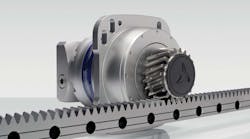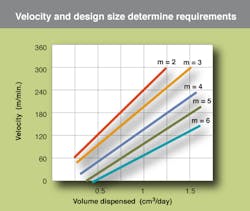Lubricating rack-and-pinion sets for long life
Effective lubrication is essential to ensuring long service life from rack-and-pinion sets because it keeps the subcomponents cool and prevents metal-to-metal contact that promotes wear. Appropriately greased sets are also most capable of reaching their highest rated speed — 1,000 ft/min. or faster — because impacts are cushioned and the pinion is allowed to smoothly engage with the rack. Finally, lubrication protects the sets against oxidation and corrosion, particularly in caustic environments.
Common methods of rack-and-pinion lubrication include schedule-based manual application and automatic lubrication with a dedicated system.
Rack-and-pinion systems that are lubricated “for life” or designated for occasional manual regreasing are often used in general motion applications requiring occasional movements for repositioning, or in lower-duty mechanisms. In these applications (such as automotive steering mechanisms) rack-and-pinion sets survive many years on their initial greasing before requiring service and relubrication. Here, the sets are run until a service schedule indicates that relubrication is due, signs of trouble appear, or adjacent components requiring service justify rack and pinion service. During shutdown servicing, the rack-and-pinion set is cleaned, and then fresh lube oil or grease is applied with a brush.
In more dynamic applications, however — those in which rack-and-pinion sets operate continuously under a normal duty cycle (from regular eight-hour shifts, to 24/7 operation) — automatic lubrication is required. It's also a necessity in applications where rack-and-pinion sets translate very large or particularly critical loads in industrial applications.
A typical automatic rack-and-pinion lubrication system consists of felt pinions, fastening axles, and lubricator sets. Subcomponents are all essential to the process.
A lubrication canister houses the lubrication for the type of application being used. A charged canister maintains pressure when not in use; closing a two-wire switch activates flow. Various sizes are available, depending on the manufacturer; selection depends on the required volume of lubricant to be dispersed over a given time.
Integrated batteries supply power so that when the lubricator is switched on, the closing of contacts triggers an electrochemical reaction. This in turn generates nitrogen that builds in a chamber until it pushes on a bellows to a piston.
The piston displaces lubricant, forcing it out of the canister and down through a plastic hose, and then into a mounting shaft, also called a fastening axis.
From there, the grease is expelled into a hollow felt greasing pinion, and out through radial holes on the pinion.
The felt pinion's position is adjusted during installation with a mounting axle so that its soft teeth can intersect with either those of the pinion or those of the rack. During operation, as the felt gear spins, the permeable surfaces of its teeth work to evenly distribute the exuded lubrication.
New products for automatic lubrication are now in the works — to allow for more flexible designs with polyurethane foam greasing pinions. Foam can absorb more grease than felt, allowing for more consistent distribution of grease.
In any case, depending on how the setup is mounted, the greasing pinion applies lubricant to either the rack or pinion — so proper positioning places the felt pinion at one of two locations. For lubrication of the pinion:
In contrast, to lubricate the rack:
The application typically determines which half of the set should be actively greased. As a general rule in particularly high-speed applications, lubricating the rack instead of the pinion can prevent grease from being flung away.
Through the use of simple DIP switches, an array of settings can be selected to control the amount of grease that flows over time — depending on the motion cycle of the rack and pinion.A sensor kit attached to the lubrication canister indicates when supplies are running low. The kit consists of a magnetic-field sensor that triggers a light signal or audible warning when the canister is about 95% empty.
For ease of use, an exchange canister can be swapped in when the original canister runs out.
Lubrication frequency and type
Grease is typically chosen over oil because it contains additives that allow it to adhere to the rack-and-pinion working surfaces more effectively. Before the initial use of a rack-and-pinion system, the subcomponents must be lubricated to ensure proper and smooth workflow. In addition, the automatic lubrication system's felt pinion should be presoaked with grease.
Once regular operation is underway, the correct amount of grease required for the application can be applied automatically and accurately, simplifying maintenance. Tables can assist engineers in determining the appropriate lubrication frequency. As noted in this article's opening table, higher rack-and-pinion speeds require higher lubrication frequency rates. Lubrication cast-off can be minimized with carefully selected arrangements, but actual consumption of lubrication is unavoidable: It occurs when grease is transferred from rack to pinion and back again, repeatedly — and slowly migrates from the working surfaces.
Note that the precision gearing found in high-performance rack-and-pinion sets is hard on lubricants: Backlash is minimized, while tolerances are tight, which makes for consistently high pressures — so the grease formulations used must be suitably durable.
Otherwise, lubricant shearing and thinning results, and the rack-and-pinion surfaces can begin to show signs of fretting and corrosion.
Case in point: One lubrication type commonly used for rack-and-pinion sets is a fluid grease called Microlube GB 0, manufactured by Klüber Lubrication München KG, a member of the Freudenberg group, with U.S. headquarters in Londonderry, N.H. This fluid grease is a mineral-oil-based lubricant with antiwear additives and without solid lubricants. Its high-pressure absorption capacity and good wetting behavior are particularly useful in linear applications. In fact, the grease was developed specifically for friction points subject to high loads and mixed friction conditions — typical of rack-and-pinion sets, as well as heavy-duty spur and bevel gears with steel-on-steel components, such as gearmotors that are not oil-tight.
Where appropriate, some automatic lubrication systems can be synchronized with actual machine runtime, which is useful on rack-and-pinion sets with idle times of one week to six months. Here, two contact cables with angle plugs provide the connectivity.
Lubrication limitations
In applications such as metal cutting, lubrication cannot protect rack-and-pinion sets against metal chips. Here, if shavings get between the gear teeth, they can effectively cut away the hardened surface. This specialized surface protects the gearing and allows it to run under high pressure for long duty cycles; if that surface is compromised, the softer cores of the components are exposed, hastening wear, microcracking, and even failure.
For these reasons, bellows covers, in addition to automated lubrication, are recommended to shield the linear drive from damage.
For more information, visit Wittenstein online.
A sidenote on going greaseless — and how hard that really is
A sizable minority of machine builders that integrate rack-and-pinion sets into their designs run the gearing with zero lubrication. Typically, these engineers omit lubrication when a design's required life is relatively short, when the cost for lubrication isn't justified, or when an application, such as textile or woodworking machinery, generates small particles that seem to contraindicate lubrication.
For these particle-producing applications, despite the potential complication of debris mixing with grease on racks, most manufacturers still strongly encourage engineers to integrate automatic lubrication. One approach is to switch to oil-spray lubrication, though this can become messy. Instead, it's recommended that rack-and-pinion sets be grease lubricated and then protected with bellows or way covers, or installed in an inverted position so that debris falls off the working gear surfaces. Why?
Greaseless rack-and-pinion designs remain an elusive ambition. Certain manufacturers offer customized sets that are coated for lube-free operation, and some OEMs regularly run rack-and-pinion sets without lubrication with relative success. Here, plating is inappropriate, as the high pressure of mating rack-and-pinion surfaces cracks it. Instead, common approaches include chemical-vapor depositions of various types, proprietary coatings by Raydent Industrial Co. Ltd., Kyoto, Japan, and diamond-like coatings (DLCs), well proven in the bearing industry.
Much more common is the use of coatings — particularly by OEMs — to completely protect critical designs against corrosion, while reducing the rate of automatic lubrication.
However, laboratory tests on coatings for lube-free rack-and-pinion operation provide incomplete quantitative data — and currently, there are no common coatings that can guarantee the same life and performance as greased designs. Future developments in this area will require cooperation between component manufacturers, machine builders, and research engineers willing to engage in testing.


